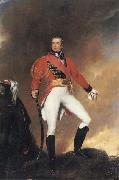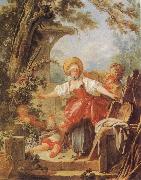Wholesale Oil Painting Reproductions No Minimum and Door to Door! |
|||||||||||
|
|
|||||||||||

|
|||||||||||
|
|
|
||||||||
All Francisco Jose de Goya Oil Paintings |
||||||||
|
|
||||||||
|
|
||||||||
|
Artist Introduction: Spanish Rococo Era/Romantic Painter and Printmaker, 1746-1828
Goya is considered the 18th Century's foremost painter and etcher of Spanish culture, known for his realistic scenes of battles, bullfights and human corruption. Goya lived during a time of upheaval in Spain that included war with France, the Inquisition, the rule of Napoleon's brother, Joseph, as the King of Spain and, finally, the reign of the Spanish King Ferdinand VII. Experts proclaim these events -- and Goya's deafness as a result of an illness in 1793 -- as central to understanding Goya's work, which frequently depicts human misery in a satiric and sometimes nightmarish fashion. From the 1770s he was a royal court painter for Charles III and Charles IV, and when Bonaparte took the throne in 1809, Goya swore fealty to the new king. When the crown was restored to Spain's Ferdinand VII (1814), Goya, in spite of his earlier allegiance to the French king, was reinstated as royal painter. After 1824 he lived in self-imposed exile in Bordeaux until his death, reportedly because of political differences with Ferdinand. Over his long career he created hundreds of paintings, etchings, and lithographs, among them Maya Clothed and Maya Nude (1798-1800); Caprichos (1799-82); The Second of May 1808 and The Third of May 1808 (1814); Disasters of War (1810-20); and The Black Paintings (1820-23). |
||||||||
|
|
||||||||
|
Blind Man's Buff Painting ID:: 10367 |
1789Oil on canvas
Museo del Prado
Madrid |
|||||||
Height Width |
INS/CM Quality |
|||||||
|
X |
| |||||||
|
|
||||||||
All Sir David Wilkie Oil Paintings |
||||||||
|
|
||||||||
|
|
||||||||
|
Artist Introduction: 1785-1841
British Sir David Wilkie Galleries
Wilkie may have inherited his rectitude and tenacity, even his nervous inhibitions, from his father, the minister of his native parish. Though little responsive to schooling, he showed an early inclination towards mimicry that expressed itself in drawings, chiefly of human activity. In these he was influenced by a copy of Allan Ramsay pastoral comedy in verse, the Gentle Shepherd (1725), illustrated by David Allan in 1788. One of the few surviving examples of his early drawings represents a scene from it (c. 1797; Kirkcaldy, Fife, Mus. A.G.). Wilkie cherished the demotic spirit of this book and its illustrations throughout his life. |
||||||||
|
|
||||||||
|
|
Blind Man's Buff Painting ID:: 27884 |
1812
Oil on canvas 63.2 x 91.8 cm
(25 x 36 1/8 in)
Royal Collection (mk63) |
||||||
Height Width |
INS/CM Quality |
|||||||
|
X |
| |||||||
|
|
||||||||
All Jean Honore Fragonard Oil Paintings |
||||||||
|
|
||||||||
|
|
||||||||
|
Artist Introduction: 1732-1806
French
Jean Honore Fragonard Locations
French painter. He studied with François Boucher in Paris c. 1749. He subsequently won a Prix de Rome, and while in Italy (1756 ?C 61) he traveled extensively and executed many sketches of the countryside, especially the gardens at the Villa d Este at Tivoli, and developed a great admiration for the work of Giovanni Battista Tiepolo. In 1765 his large historical painting Coresus Sacrifices Himself to Save Callirhoë was purchased for Louis XV and won Fragonard election to the French Royal Academy. He soon abandoned this style to concentrate on landscapes in the manner of Jacob van Ruisdael, portraits, and the decorative, erotic outdoor party scenes for which he became famous (e.g., The Swing, c. 1766). The gentle hedonism of such party scenes epitomized the Rococo style. Although the greater part of his active life was passed during the Neoclassical period, he continued to paint in a Rococo idiom until shortly before the French Revolution, when he lost his patrons and livelihood.
|
||||||||
|
|
||||||||
|
|
Blind Man's Buff Painting ID:: 33772 |
mk86
c.1760
Oil on canvas
114x90cm
Toledo,Toledo
Museum of Art
|
||||||
Height Width |
INS/CM Quality |
|||||||
|
X |
| |||||||
|
|
||||||||
|
Prev Next
|
||||||||
|
|
||||||||
|
Related Paintings to Jean Honore Fragonard :. |
||||||||
|
|
||||||||
|
CONTACT US |



